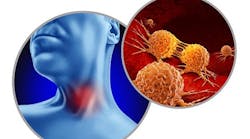Parkinson’s disease is a chronic, progressive degenerative disorder of the central nervous system. A new study estimates that nearly 90,000 people in the US are diagnosed with the disease each year, and the number of people living with Parkinson’s is expected to rise to 1.2 million by 2030.1
Parkinson’s is associated with the degeneration and loss of dopamine-producing neurons in the nigrostriatal portion of the brain and loss of function in the limbic, motor, and autonomic systems.2-4 It is characterized by the presence of Lewy bodies, destructive lesion structures strongly correlated with neuron degeneration and considered a diagnostic marker for the disease.5,6
Parkinson’s disease results from a combination of environmental, genetic, and other contributing factors.6 People with parents or siblings diagnosed with Parkinson’s may have a greater chance of developing the disease. Other contributing factors to the development of the disease include oxidative damage to the brain from free radicals, trauma from stroke, brain tumor, and head injury.6
You may also be interested in ... Do you really know what oral-systemic means?
Parkinson’s leads to decreased controlled motor function and balance, mood and behavior disorders, impairment in the performance of the daily activities of living, and thus, reduced quality of life.7 Typically, symptoms appear in patients older than 50, although some variants of the disease affect patients under the age of 40.8 By the time symptoms emerge, there is a loss of approximately 60%–80% of dopamine-producing cells in the substantia nigra and other areas of the brain.9
Primary symptoms of Parkinson’s include resting tremor (tremor in the hands is the most noticeable symptom), muscle rigidity, reduced facial expression, and gait instability. The tremor can be unilateral or bilateral, may produce a “pill-rolling” movement of the thumb and opposing fingers, and may also affect the jaw, tongue, and eyelids.2
Muscle rigidity often manifests as reduced swinging of the arms, foot dragging, and shuffling while walking. Other motor disturbances include bradykinesia, an overall slowness of movement, and akinesia, a significant reduction in or sudden inability to initiate spontaneous movement, resulting in “freezing.” These motor disturbances often manifest as reduced facial expression (“facial mask”) and reduced blinking and swallowing.2
Another related syndrome, akathisia, a subjective feeling of restlessness, may be manifested as restless leg syndrome. Postural instability and gait difficulties ultimately may be the most disabling aspect of Parkinson’s, leading to falls that cause injury (including injury to orofacial structures).10
Patients may also have a wide spectrum of nonmotor disturbances. Autonomic dysfunction, noted in more than half of patients, manifests as variations in blood pressure (particularly orthostatic hypotension), cardiac dysrhythmias, excessive sweating, bladder/bowel dysfunction, and sexual dysfunction.10
Pharmacologic management
Pharmacologic management of Parkinson’s disease is usually initiated when symptoms interfere with the patient’s level of functioning.11 Medication therapy, however, has not been proven to alter the underlying progression of the disease. Therapy is aimed at increasing dopamine levels in the brain. Dopamine itself cannot be administered because it does not cross the blood-brain barrier. Levodopa, the immediate precursor of dopamine, is metabolized to dopamine in both brain and peripheral tissues. The combination of levodopa with carbidopa, a peripheral metabolic inhibitor, is an effective treatment for Parkinson’s.12
Entacapone is a medication that blocks the enzyme COMT and thus prevents levodopa breakdown in the intestine. It is available in combination with carbidopa/levodopa as Stalevo.12 Selegiline (Eldepryl) blocks the enzyme MAO-B to inhibit breakdown of dopamine in the brain, prolonging the effect of levodopa.13 Selegiline, unfortunately, is metabolized to amphetamine by-products, which have been implicated in causing cardiac dysrhythmias and sensitivity to epinephrine.13
Adverse effects of these medications mimic those of the disease, including dyskinesias and psychosis.14-16 Treatment with levodopa is associated with an increased incidence of orthostatic hypotension and syncope.17,18 Long-term (five years or longer) administration of levodopa results in 50%–75% of patients becoming partially unresponsive to the medication.12 Patients may also develop levodopa-induced dystonias, which manifest as abnormal, involuntary movements of the extremities, trunk, feet, head, face, tongue, or muscles of mastication.14
Dopamine agonist medications used in the treatment of disease, such as pramipexole (Mirapex) and ropinirole (Requip), stimulate dopamine receptors directly. However, adverse effects of these medications mimic symptoms of the disease itself.15
Anticholinergics, such as trihexyphenidyl (Artane) and benztropine (Cogentin), block the effects of acetylcholine to rebalance its levels with dopamine. These medications are useful for the treatment of tremor and drooling associated with Parkinson’s. Adverse effects—including impaired memory, confusion and hallucinations, xerostomia, constipation, and urinary retention—limit their usefulness in older patients.11 Cannabis as a treatment of disease symptoms is widespread and well documented.
Dental hygiene considerations
The symptoms of Parkinson’s disease present unique challenges for patients in withstanding dental hygiene treatment.19-21 Patients may experience exaggerated trembling and involuntary shaking, so proper precautions should be taken to prevent needlestick injury. These patients have difficulty with movement and ambulation and often experience orthostatic hypotension. Proper chair positioning is essential.
Many patients experience physical and mental fatigue and bowel dysfunction. Dental professionals should modify treatment plans involving extended chair time to allow frequent rests and restroom trips.20,21 Patients with Parkinson’s often experience anxiety, mood disorders, and compulsive behaviors, which may result in reduced tolerance and cooperation.19-21 Adequate anesthesia, good pain control and anxiety- and stress-reduction techniques are essential.
Patients with Parkinson’s have varying degrees of dyskinesia of the hands and face, which is often associated with poor oral hygiene. Treatment plans may require modification based on the patient’s ability to cleanse the oral cavity, including the use of adapted toothbrushes and devices that are easier to grasp and hold.
Editor's note: This article appeared in the July 2023 print edition of RDH magazine. Dental hygienists in North America are eligible for a complimentary print subscription. Sign up here.
References
- Number of people diagnosed with Parkinson’s increases to nearly 90,000 each year. Parkinson’s Foundation. December 15, 2022. Accessed January 1, 2023. https://www.parkinson.org/blog/research/incidence-2022
- Friedlander AH, Mahler M, Norman KM, Ettinger RL. Parkinson disease: systemic and orofacial manifestations, medical and dental management. J Am Dent Assoc. 2009;140(6):658-669. doi:10.14219/jada.archive.2009.0251
- Frank C, Pari G, Rossiter JP. Approach to diagnosis of Parkinson disease. Can Fam Physician. 2006;52(7):862-868.
- Bhat V, Weiner WJ. Parkinson’s disease: diagnosis and the initiation of therapy. Minerva Med. 2005;96(3):145-154.
- Forman MS, Lee VMY, Trojanowski JQ. Nosology of Parkinson’s disease: looking for the way out of the quagmire. Neuron. 2005;47(4):479-482. doi:10.1016/j.neuron.2005.07.021
- Lang A. Parkinson’s disease. In: Goldman L, Ausiello D, eds. Cecil Textbook of Medicine. W.B. Saunders Company; 2007;23:2726-2733.
- Ravina B, Camicioli R, Como PG, et al. The impact of depressive symptoms in early Parkinson disease. Neurol. 2007;69(4):342-347. doi:10.1212/01.wnl.0000268695.63392.10
- Parkinson’s Today Blog: 10 helpful young-onset Parkinson’s resources. Parkinson’s Foundation. August 11, 2020. Accessed January 1, 2023. https://www.parkinson.org/blog/tips/young-onset-resources
- Hawkes CH, Del Tredici K, Braak H. A timeline for Parkinson’s disease. Parkinsonism Relat Disord. 2010;16(2):79-84. doi:10.1016/j.parkreldis.2009.08.007
- Dirks SJ, Paunovich ED, Terezhalmy GT, Chiodo LK. The patient with Parkinson’s disease. Quintessence Int. 2003;34(5):379-393.
- Hauser RA, Zesiewicz TA. Advances in the pharmacologic management of early Parkinson disease. Neurologist. 2007;13(3):126-132. doi:10.1097/01.nrl.0000256433.15481.eb
- Stocchi F. Optimising levodopa therapy for the management of Parkinson’s disease. J Neurol. 2005;252(suppl 4):IV43-IV48. doi:10.1007/s00415-005-4009-4
- Pålhagen S, Heinonen E, Hägglund J, et al. Swedish Parkinson Study Group. Selegiline slows the progression of the symptoms of Parkinson disease. Neurol. 2006;66(8):1200-1206. doi:10.1212/01.wnl.0000204007.46190.54
- Van Gerpen JA, Kumar NJ, Bower JH, Weigand S, Ahlskog JE. Levodopa-associated dyskinesia risk among Parkinson disease patients in Olmsted County, Minnesota, 1976-1990. Arch Neurol. 2006;63(2):205-209. doi:10.1001/archneur.63.2.205
- Visser M, Verbaan D, van Rooden SM, Stiggelbout AM, Marinus J, van Hilten JJ. Assessment of psychiatric complications in Parkinson’s disease: the SCOPA-PC. Mov Disord. 2007;22(15):2221-2228. doi:10.1002/mds.21696
- Thanvi BR, Lo TCN, Harsh DP. Psychosis in Parkinson’s disease. Postgrad Med J. 2005;81(960):644-646. doi:10.1136/pgmj.2004.032029
- Goldstein DS, Eldadah BA, Holmes C, et al. Neurocirculatory abnormalities in Parkinson disease with orthostatic hypotension: independence from levodopa treatment. Hypertension. 2005;46(6):1333-1339. doi:10.1161/01.HYP.0000188052.69549.e4
- Korchounov A, Kessler KR, Schipper HI. Differential effects of various treatment combinations on cardiovascular dysfunction in patients with Parkinson’s disease. Acta Neurol Scand. 2004;109(1):45-51. doi:10.1034/j.1600-0404.2003.00172.x
- Persson M, Osterberg T, Granérus AK, Karlsson S. Influence of Parkinson’s disease on oral health. Acta Odontol Scand. 1992;50(1):37-42. doi:10.3109/00016359209012744
- Collins R. Special considerations for the dental patient with Parkinson’s disease. Tex Dent J. 1990;107(3):31-32.
- Alexander RE, Gage TW. Parkinson’s disease: an update for dentists. Gen Dent. 2000;48(5):572-580.






